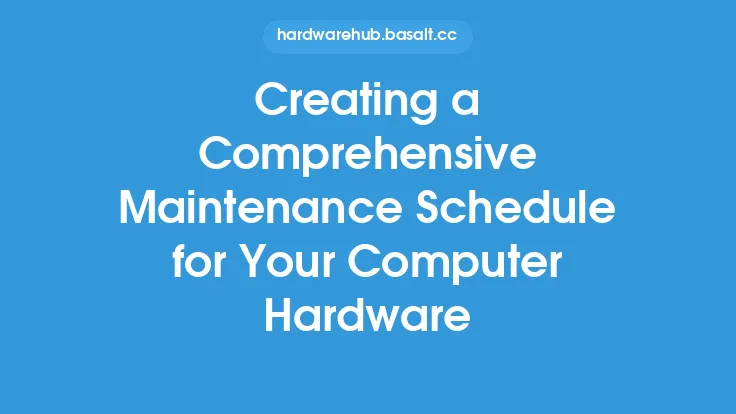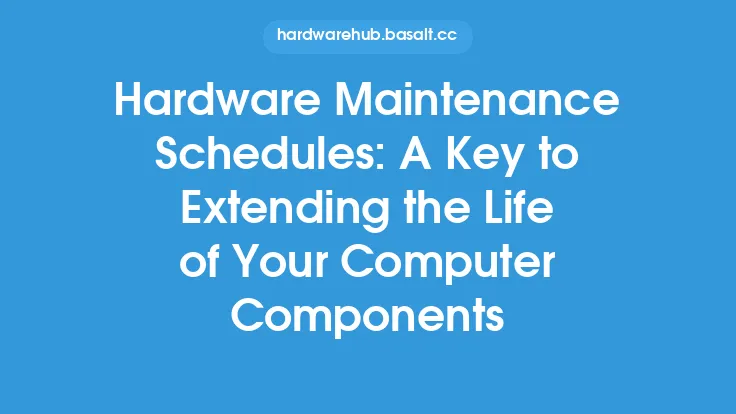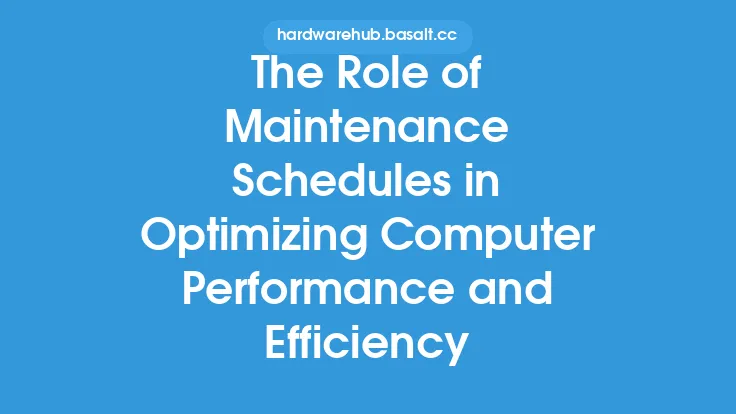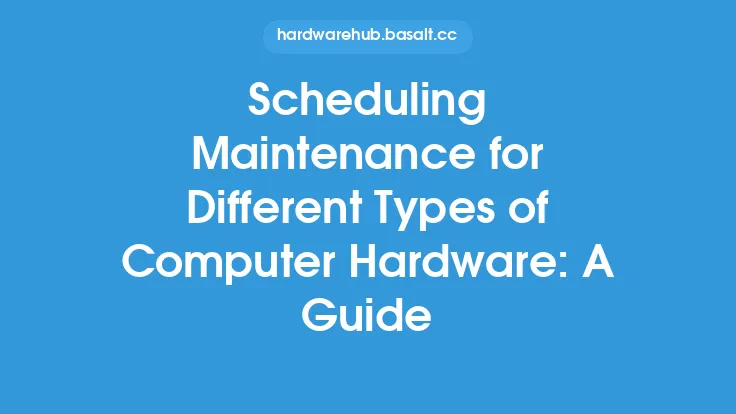Implementing a preventive maintenance schedule for computer hardware is crucial for ensuring the longevity and optimal performance of computer systems. By proactively maintaining hardware components, users can prevent unexpected failures, reduce downtime, and minimize the risk of data loss. A well-planned maintenance schedule can help identify potential issues before they become major problems, allowing for prompt repairs or replacements. This approach not only saves time and money but also helps to prevent the frustration and disruption that can come with unexpected hardware failures.
Introduction to Preventive Maintenance
Preventive maintenance involves regularly inspecting and maintaining computer hardware to prevent problems from arising. This can include tasks such as cleaning dust from fans and heat sinks, checking for loose connections, and verifying that all components are functioning correctly. By performing these tasks on a regular schedule, users can help to prevent overheating, reduce the risk of electrical failures, and ensure that all components are working together seamlessly. Preventive maintenance can be performed on a variety of hardware components, including CPUs, motherboards, RAM, graphics cards, and storage devices.
Benefits of Preventive Maintenance
The benefits of implementing a preventive maintenance schedule for computer hardware are numerous. One of the most significant advantages is the reduction of downtime. By identifying and addressing potential issues before they become major problems, users can minimize the amount of time their computer is out of commission. This is especially important for businesses and individuals who rely on their computers for critical tasks. Preventive maintenance can also help to reduce the risk of data loss, which can be devastating for individuals and organizations. By ensuring that hardware components are functioning correctly, users can help to prevent data corruption and loss.
Types of Preventive Maintenance
There are several types of preventive maintenance that can be performed on computer hardware. One of the most common is visual inspection, which involves checking for signs of wear and tear, such as dust buildup, corrosion, or physical damage. Users can also perform functional tests to verify that all components are working correctly. This can include running diagnostic software to test the performance of CPUs, memory, and storage devices. Another type of preventive maintenance is cleaning, which involves removing dust and debris from fans, heat sinks, and other components. This can help to improve airflow, reduce temperatures, and prevent overheating.
Scheduling Preventive Maintenance
To get the most out of preventive maintenance, it's essential to schedule tasks on a regular basis. The frequency of maintenance will depend on the type of hardware, usage patterns, and environmental conditions. For example, computers that are used in dusty or humid environments may require more frequent cleaning and inspection. Users can create a maintenance schedule based on the manufacturer's recommendations, usage patterns, and the age of the hardware. It's also important to keep track of maintenance tasks, including the date, time, and results of each task. This can help to identify trends and patterns, making it easier to anticipate and prevent future problems.
Tools and Software for Preventive Maintenance
There are a variety of tools and software available to help users perform preventive maintenance on their computer hardware. Diagnostic software, such as CPU-Z and GPU-Z, can provide detailed information about hardware components, including performance metrics and error logs. Cleaning tools, such as compressed air and soft brushes, can help to remove dust and debris from fans and heat sinks. Users can also utilize software tools, such as disk cleanup and disk defragmentation utilities, to optimize storage devices and improve system performance. Additionally, many manufacturers provide specialized software and tools for maintaining their hardware components.
Best Practices for Preventive Maintenance
To ensure the effectiveness of preventive maintenance, it's essential to follow best practices. One of the most important is to ground yourself before handling hardware components to prevent static electricity damage. Users should also ensure that the computer is turned off and unplugged before performing maintenance tasks. It's also crucial to use the correct tools and software for each task, as using the wrong tools can cause damage to hardware components. Users should also keep track of maintenance tasks, including the date, time, and results of each task, to help identify trends and patterns. Finally, users should always follow the manufacturer's recommendations for maintenance and repair to ensure that their hardware components are properly cared for.
Common Preventive Maintenance Tasks
There are several common preventive maintenance tasks that users can perform on their computer hardware. One of the most important is cleaning dust from fans and heat sinks. This can help to improve airflow, reduce temperatures, and prevent overheating. Users can also check for loose connections, verify that all components are securely fastened, and ensure that cables are properly routed. Additionally, users can run diagnostic software to test the performance of CPUs, memory, and storage devices. They can also update drivers and firmware to ensure that hardware components are running with the latest software. Finally, users can perform disk cleanup and disk defragmentation to optimize storage devices and improve system performance.
Conclusion
Implementing a preventive maintenance schedule for computer hardware is essential for ensuring the longevity and optimal performance of computer systems. By proactively maintaining hardware components, users can prevent unexpected failures, reduce downtime, and minimize the risk of data loss. A well-planned maintenance schedule can help identify potential issues before they become major problems, allowing for prompt repairs or replacements. By following best practices, using the correct tools and software, and scheduling tasks on a regular basis, users can help to ensure that their computer hardware is properly cared for and functioning at its best. Whether you're a home user or a business, preventive maintenance is an essential part of computer ownership, and it's crucial to make it a priority to get the most out of your hardware.





